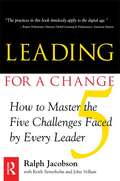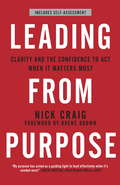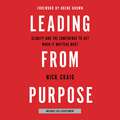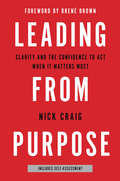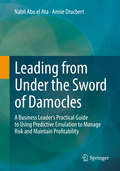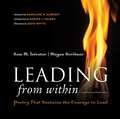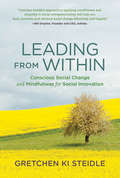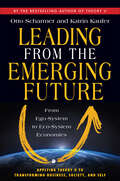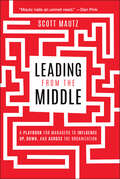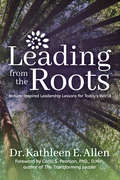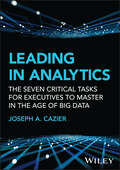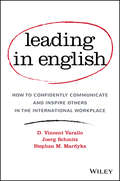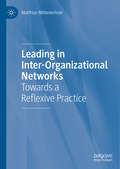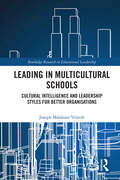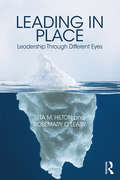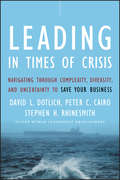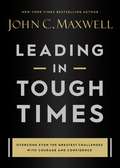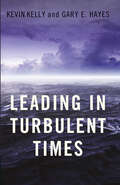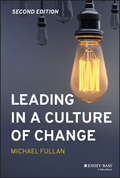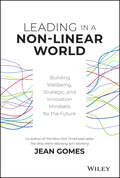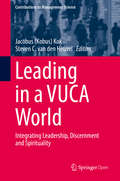- Table View
- List View
Leading for a Change: How To Master The 5 Challenges Faced By Every Leader
by Ralph D. JacobsonBringing together the best practices of many of the most highly respected organizational thinkers shaping the future landscape of business, Leading for a Change finally answers the question of how to make leadership success a reality. This book is relevant for all leaders within the organization-from the shop floor, to those pushing the envelop with e-commerce to walnut row. The book's "5 Challenges of Organizational Leadership" enables readers to concentrate on specific tasks crucial to creating a unified, visionary and dynamic organization. The author's unique Leader's Map framework lays out the five universal challenges facing today's leaders: reframing the future, developing followership, teaching and learning, building community, and balancing paradox. The book's leadership "roadmap" and diagnostic surveys help readers assess their organization's current and emerging leadership challenges and devise new adaptable and anticipatory strategies. Drawing from the works of such luminary business gurus as Kouzes & Posner, Senge, Covey, Bennis, Hamel and others, the author has translated their wisdom into practical tools that bring clarity to the order and rhythm of what it takes to be a successful leader. Leading for a Change is straightforward and free from jargon. The unique underlying principles of the book are: Leadership can be learned, thus it is less art and mostly practice Leadership need not be a solo act. Leaders support each other to accomplish organization objectives The most successful leaders focus on using their strengths effectively Effective leaders learn to use leadership tools in ways that are natural to them
Leading from Any Chair: Empowering Those We Lead to Realize their Full Potential and to Become Leaders Themselves
by Rosamund Stone Zander Benjamin ZanderA monumental question for leaders in any organization to consider is: How much greatness are we willing to grant people? Because it makes all the difference at every level who it is we decide we are leading. The activity of leadership is not limited to conductors, presidents, and CEOs, of course--the player who energizes the orchestra by communicating his newfound appreciation for the tasks of the conductor, or a parent who fashions in her own mind that her children desire to contribute, is exercising leadership of the most profound kind. Enabling this kind of engagement from the people we lead, encouraging them to perform to their fullest potential, is described in this chapter as the ability to lead from any chair. The authors provide several examples of what this looks like in practice and remind us that leaders can be found anywhere--not just on podiums or in corner offices--if we embrace this idea. This chapter was originally published as Chapter 5 of "The Art of Possibility: Transforming Professional and Personal Life."
Leading from Anywhere: The Essential Guide to Managing Remote Teams
by David Burkus&“Leading from Anywhere is the best book on remote work I&’ve ever read —incisive, original, and eminently practical. Read it —and take notes!&”—Daniel H. Pink, author of When, Drive, and To Sell Is Human The ultimate guide to leading remote teams, tackling the key challenges that managers face —from hiring and onboarding new members from afar to building culture remotely, tracking productivity, communicating speedily, and avoiding burnout It&’s undeniable that we&’re entering a new era of remote work. While many leaders seek to run business as usual, why settle for the usual when remote teams allow us to work even better? The research shows that employees are more productive and engaged when they have the freedom to work from anywhere. Which means leaders need the skills to lead from anywhere. In this meticulously researched, refreshingly practical book, top business thought leader David Burkus provides managers with the field guide to leading remotely, packed with everyday examples and illuminating insights. Structured around the life cycle of working on a team, Burkus tackles the key inflection points and challenges that remote managers face, from taking the team remote and adding new members to communicating effectively and quickly, managing performance, keeping the team engaged, and even helping them strike the right balance between work and life.Leading from Anywhere provides everything you&’ll need to survive and thrive as the leader of a remote team —something all leaders will need to consider themselves from now on.
Leading from Purpose: Clarity and confidence to act when it matters
by Nick Craig'Will transform your leadership as you discover your authentic purpose'Bill George, former Chair and CEO of Medtronic'Working with Craig dramatically changed my professional path and I can't imagine leading Ben & Jerry's without it'Jostein Solheim, CEO of Ben & Jerry's Drawing on ten years of experience working with more than 10,000 executives from companies around the world, Nick Craig takes you on a revelatory journey to understand your purpose, find clarity and focus and lead with inspiration.When uncovered, purpose becomes our most fundamental guiding principle. Explaining where true purpose lies and demystifying where it doesn't, Craig offers the methods through which anyone can find their purpose. He identifies three pathways that will assess where you are going with your purpose and where you should be going.In Leading from Purpose, Craig shares unique stories to show how top leaders are energized by their purpose, finding in it the confidence they need to properly evaluate high-stakes decisions and take the optimal action. Accessible, methodical and eminently practical, this book offers the comprehensive toolbox with which everyone - whether a c-suite executive or a behind-the-scenes office worker - can live out their purpose and achieve success on their own terms.
Leading from Purpose: Clarity and confidence to act when it matters
by Nick Craig'Will transform your leadership as you discover your authentic purpose'Bill George, former Chair and CEO of Medtronic'Working with Craig dramatically changed my professional path and I can't imagine leading Ben & Jerry's without it' Jostein Solheim, CEO of Ben & Jerry's Drawing on ten years of experience working with more than 10,000 executives from companies around the world, Nick Craig takes you on a revelatory journey to understand your purpose, find clarity and focus and lead with inspiration.When uncovered, purpose becomes our most fundamental guiding principle. Explaining where true purpose lies and demystifying where it doesn't, Craig offers the methods through which anyone can find their purpose. He identifies three pathways that will assess where you are going with your purpose and where you should be going.In Leading from Purpose, Craig shares unique stories to show how top leaders are energized by their purpose, finding in it the confidence they need to properly evaluate high-stakes decisions and take the optimal action. Accessible, methodical and eminently practical, this book offers the comprehensive toolbox with which everyone - whether a c-suite executive or a behind-the-scenes office worker - can live out their purpose and achieve success on their own terms.With a foreword by Daring Greatly author Brené Brown.(P)2018 Hachette Audio
Leading from Purpose: Clarity and the Confidence to Act When It Matters Most
by Nick CraigDRAWING ON TEN YEARS OF EXPERIENCE WORKING WITH MORE THAN 10,000 EXECUTIVES FROM COMPANIES AROUND THE GLOBE, NICK CRAIG TAKES YOU ON A REVELATORY JOURNEY TO UNDERSTAND YOUR PURPOSE, FIND CLARITY AND FOCUS, AND LEAD WITH INSPIRATION.When uncovered, purpose becomes our most fundamental guiding principle. Explaining where true purpose lies and demystifying where it doesn't, Craig offers the methods through which anyone can find their purpose. He identifies three pathways that will assess where you are with your purpose and where you should be going. Illustrated by case studies of leaders from all walks of life and industries, Craig shares their unique stories to show how top leaders are energized by their purpose, finding in it the confidence they need to properly evaluate high-stakes decisions and take the optimal action. The best leaders access their purpose especially when facing the unknown, drawing on the source of it to energize themselves. Purpose also redefines their relationships to stress, allowing them to thrive where others just survived, and to postpone momentary, fleeting rewards in favor of leaving a sustained, meaningful impact. Accessible, methodical, and eminently practical, Leading from Purpose offers the comprehensive toolbox with which everyone--whether a c-suite executive of behind-the-scenes office worker--can live out their purpose and achieve success on their own terms. If you find yourself in an organization that is struggling to live its purpose, Craig's insights on how to bring your purpose and the organization's purpose into the same room at the same time is game-changing and will redefine your life and career.
Leading from Under the Sword of Damocles: A Business Leader's Practical Guide To Using Predictive Emulation To Manage Risk And Maintain Profitability
by Nabil Abu el Ata Annie DrucbertGlobalization trends and the rapid pace of technological innovations have introduced unprecedented change and uncertainty. For unprepared businesses, the drivers of the Fourth Industrial Revolution will become a constant source of surprise and crises will unfold at an ever-increasing rate. To thrive under these conditions, companies must adopt new risk management technologies and practices that enable business leaders to better anticipate and adjust to changing dynamics.This book helps readers understand how algorithm-based predictive and prescriptive analytics principles can be used to control risk in today’s dynamic business environment. It serves as a reference guide for business leaders and risk management practitioners of companies that are global in reach or operate dynamically complex systems. Using the technological and scientific innovations presented in this book, business leaders can gain a wider understanding of risk and prescriptively determine which actions are necessary to ensure the business is optimally positioned to meet its stated long-term goals and objectives.Case studies show how the presented methods can be practically applied to preemptively expose risks and support decisions to optimize, transform or disrupt current business models, strategies, organizational structure and information systems when necessary to maintain a market position or outperform competitors.These methods have been proven through hundreds of client cases. By using mathematical emulation to link business risks to strategic imperatives, it becomes possible to achieve a higher annual profit margin and better growth. As we enter the Fourth Industrial Revolution, companies that are able to expose risks caused by dynamic complexity and maintain the alignment between the goals of the business and operational execution will be better prepared to make the shifts necessary for long-term success and keep the business moving toward its goals.
Leading from Within
by Megan Scribner Sam M. IntratorLeading from Within is a wonderful collection of ninety-three poems from well-loved poets, each of which is accompanied by a brief personal commentary from a leader explaining the significance and meaning of the poem in his or her life and work. The contributors represent a wide range of professions including Vanguard Group founder John Bogle, MoveOn.org cofounder Joan Blades, several members of Congress, Christian activist Brian McLaren, business guru Peter Senge, and many other leaders from business, medicine, education, nonprofits, law, politics and government, and religion. In their reflections, these leaders explore how they have been inspired by poets such as T.S. Eliot, Mary Oliver, William Stafford, Langston Hughes, Pablo Neruda, Robert Frost, Rumi, May Sarton, Wallace Stevens, Wendell Berry, and Rainer Maria Rilke."Leading from Within is perhaps the most soulful treatment of leadership ever composed. Leadership is first an inner quest, and there is absolutely no better place to explore your inner territory than in the pages of this book. This is an evocative work of art; do yourself an immense favor, and engage with these amazing and diverse leaders and their poems."--Jim Kouzes, coauthor of the bestselling The Leadership Challenge and A Leader's Legacy"Leading from Within makes brilliant use of the world's great poets to inspire us to lead with our hearts as well as our heads. It calls to the deeper purpose and meaning within all of us to use our gifts to serve others."--Bill George, author, True North: Discover Your Authentic Leadership"This is a superb collection of poems and deeply personal reflections from a wide range of real leaders. It is a gift to all of us who believe in bringing our hearts to our work."--Rep. John Lewis (D-Ga.)"The entries in this wonderful anthology are a joy to read and all the more interesting because of their special meaning to the leaders who recommended them. It is a book that every nonprofit leader should place among those they draw upon for inspiration every day."--Diana Aviv, president and CEO, Independent Sector"Leading from Within offers a candid view straight into the heart and soul of leaders striving to do good and effective work in the world. The poems and commentaries remind us that leadership is always deeply personal and chock-full of dilemmas that must be addressed by creativity, passion, imagination, and courage."--Jeff Swartz, president and CEO, Timberland
Leading from Within: Conscious Social Change and Mindfulness for Social Innovation (The\mit Press Ser.)
by Gretchen Ki SteidleA roadmap for integrating mindfulness into every aspect of social change: how to lead transformation with compassion for the needs and perspectives of all people.Gretchen Steidle knows first-hand the personal transformation that mindfulness practice can bring. But she doesn't believe that transformation stops at personal wellbeing. In Leading from Within, Steidle describes the ways that personal investment in self-awareness shapes leaders who are able to inspire change in others, build stronger relationships, and design innovative and more sustainable solutions. Steidle argues that both personal and societal transformation are essential for a just society, and with this book she offers a roadmap for integrating mindfulness into every aspect of social change. Conventional methods attempt to compel people to change through incentives or punitive measures. Conscious social change calls for leading with a deeper human understanding of change and compassion for the needs and perspectives of all stakeholders.Steidle offers mindfulness practices for individuals and groups, presents the neuroscientific evidence for its benefits, and argues for its relevance to social change. She describes five capacities of conscious social change, devoting a chapter to each. She writes about her own experiences, including her work helping women to found their own grassroots social ventures in post-conflict Africa. She describes the success of a group of rural, uneducated women in Rwanda, for example, who now provide 9,000 villagers with clean water, ending the sexual exploitation of disabled women unable to collect water on their own. Steidle also draws from the work of change agents in the United States to showcase applications of conscious social change to timely issues like immigration, racism, policing, and urban violence. Through personal stories and practical guidance, Steidle delivers both the inspiration and tools of this innovative approach to social transformation.About Global Grassroots: In post-conflict Africa, Global Grassroots equips emerging women leaders, including war survivors, subsistence farmers, and the undereducated, with the tools and resources to create conscious social change. Our core program is our Academy for Conscious Change, a social entrepreneurship and mindfulness-based leadership program that helps vulnerable women design their own non-profit solutions to address priority social issues. In our first decade of operations we have trained over 650 change agents who have designed 150 civil society organizations benefiting over 150,000 people.
Leading from Your Gut: How You Can Succeed by Harnessing the Power of Your Values, Feelings, and Intuition
by John TownsendAs a leader, your decisions are critical. They have a significant effect on you and everyone around you. But the effective leader needs to have more than just logic, facts, and financials to help make the best choices. Leaders also must access their own intuition, that gut feeling inside.Dr. John Townsend knows that a leader’s internal world—the world of intuition, creativity, emotion, and spirituality—is just as important as the external world of data and best practices. Who you are on the inside determines your success as a leader even more than the things you do or the things you know. “You were designed with both an external world and an inner world,” Townsend says, “and they work well together. Accessing both of these areas will take a little knowledge and a little work, but it will help you be the leader you want to be.” In Leading from Your Gut, you’ll learn how leaders excel not just through external competencies and skills but by drawing on their internal world and personal experience. You’ll explore how to harness the power of your values, thoughts, emotions, and relationships to better meet the complex demands of leadership. As you apply Townsend’s principles, you will see great results in your leadership. But more importantly, you’ll experience the kind of personal transformation that will enable you to lead as a whole person. Leading from Your Gut will help emerging and veteran leaders alike to hone their intuition and become the leader they were meant to be.
Leading from the Emerging Future: From Ego-System to Eco-System Economies
by Otto Scharmer Katrin KauferOur Time Is Now We have entered an age of disruption. Financial collapse, climate change, resource depletion, and a growing gap between rich and poor are but a few of the signs. Otto Scharmer and Katrin Kaufer ask, why do we collectively create results nobody wants? Meeting the challenges of this century requires updating our economic logic and operating system from an obsolete “ego-system” focused entirely on the well-being of oneself to an eco-system awareness that emphasizes the well-being of the whole. Filled with real-world examples, this thought-provoking guide presents proven practices for building a new economy that is more resilient, intentional, inclusive, and aware. “A watershed! An inspiring, practical weaving of the inner and outer dimensions of the systemic changes so many around the world are now working toward.” —Peter Senge, Senior Lecturer, MIT Sloan School of Management; Founding Chair, Society for Organizational Learning; and author of The Fifth Discipline “Scharmer and Kaufer have succeeded in writing the book that has the potential to transform civilization from one based on a rapacious, ego-driven economics to a viable, ecological, awareness-based model. This is a must-read for anyone who cares. It may well be the single most important book you ever read.” —Arthur Zajonc, President, Mind and Life Institute, and author of Meditation as Contemplative Inquiry “Scharmer and Kaufer provide a creative and practical approach to shifting our economies. I see business as a movement, and this book shares that movement with the world, offering us inspiration to tap into the deeper levels of our humanity and urging us to transform the crises of our times.” —Eileen Fisher, founder, Eileen Fisher, Inc. “The shift to an eco-system economy is emerging everywhere around us. Otto’s and Katrin’s clarity in identifying that this shift requires change-makers to expand our thinking from the head to the heart has helped me to be more intentional in designing processes to awaken the hearts of entrepreneurs everywhere. This is a necessary condition for the emergence of the new economy.” —Michelle Long, Executive Director, Business Alliance for Local Living Economies “The purpose of business is to enhance the well-being of society. The 4.0 framework for transforming capitalism matters because it addresses a blind spot in our current discourse: how to create institutional innovations that could shift our economy from ego- to eco-system awareness at the scale of the whole.” —Guilherme Peirão Leal, founder and Cochairman, Natura Cosméticos
Leading from the Middle: A Playbook for Managers to Influence Up, Down, and Across the Organization
by Scott MautzThe definitive playbook for driving impact as a middle manager Leading from the Middle: A Playbook for Managers to Influence Up, Down, and Across the Organization delivers an insightful and practical guide for the backbone of an organization: those who have a boss and are a boss and must lead from the messy middle. Accomplished author and former P&G executive Scott Mautz walks readers through the unique challenges facing these managers, and the mindset and skillset necessary for managing up and down and influencing what happens across the organization. You’ll learn the winning mindset of the best middle managers, how to develop the most important skills necessary for managing from the middle, how to create your personal Middle Action Plan (MAP), and effectively influence: Up the chain of command, to your boss and those above them Down, to your direct reports and teams who report to you Laterally, to peers and teams you have no formal authority over Anyone in an organization who reports to someone and has someone reporting to them must lead from the middle. They are the most important group in an organization and have a unique opportunity to drive impact. Leading from the Middle explains how.
Leading from the Roots: Nature-Inspired Leadership Lessons for Today's World
by Dr. Kathleen E. AllenCan we design organizations in a way that creates a space where employees, the organization, and the larger community all thrive?And if so, where can we go for inspiration to help us achieve this goal?In a time of volatile and complex uncertainty, it is time to learn the lessons that nature has compiled from 3.8 billion years of research and development. Nature is an interdependent, dynamic and living system – just like today&’s organizations and communities. Kathleen Allen uses nature as a model, mentor, and muse to rethink how leadership is practiced today. Leading from the Roots takes nature as a source of inspiration to help organizations see a new way of leading and designing workplace structure, applying the generous framework found in mature ecologies to human organizations.Kathleen Allen helps shift assumptions, practices, structures, and processes of organizations to become more resilient and nourishing for all, and, along the way, design the way out of workplace dysfunction and drama.&“Leading from the Roots provides a powerful new way of thinking about organizations as living systems and delivers practical leadership frameworks for individuals to learn how to unleash the energy and create innovative, effective teams. -Anne Boneparte, CEO AppthorityThis book is a must read for organizational leaders who are not only committed to their mission, but equally to creating a workplace that attracts and retains the brightest and the best professionals fully enabled to meet that mission. -Caryl Stern, President & CEO UNICEF USA
Leading in Analytics: The Seven Critical Tasks for Executives to Master in the Age of Big Data (Wiley and SAS Business Series)
by Joseph A. CazierA step-by-step guide for business leaders who need to manage successful big data projects Leading in Analytics: The Critical Tasks for Executives to Master in the Age of Big Data takes you through the entire process of guiding an analytics initiative from inception to execution. You’ll learn which aspects of the project to pay attention to, the right questions to ask, and how to keep the project team focused on its mission to produce relevant and valuable project. As an executive, you can’t control every aspect of the process. But if you focus on high-impact factors that you can control, you can ensure an effective outcome. This book describes those factors and offers practical insight on how to get them right. Drawn from best-practice research in the field of analytics, the Manageable Tasks described in this book are specific to the goal of implementing big data tools at an enterprise level. A dream team of analytics and business experts have contributed their knowledge to show you how to choose the right business problem to address, put together the right team, gather the right data, select the right tools, and execute your strategic plan to produce an actionable result. Become an analytics-savvy executive with this valuable book. Ensure the success of analytics initiatives, maximize ROI, and draw value from big data Learn to define success and failure in analytics and big data projects Set your organization up for analytics success by identifying problems that have big data solutions Bring together the people, the tools, and the strategies that are right for the jobBy learning to pay attention to critical tasks in every analytics project, non-technical executives and strategic planners can guide their organizations to measurable results.
Leading in English: How to Confidently Communicate and Inspire Others in the International Workplace
by D. Vincent Varallo Joerg Schmitz Stephan M. MardyksA Guide for English communication amongst international professionals Leading in English provides a valuable resource for more effective international business communication. Whether you're a non-native English speaker working in English every day, or a native speaker working with non-native speakers, this book levels the playing field with a host of insights and tips using real-time examples. Through shared experiences and an engaging narrative, you'll gain confidence as you build the skills you need to communicate more effectively in the workplace. Impart information, relate to coworkers, or just have a friendly chat—this book helps remove uncertainty and streamline interactions. Whether language is a small stumbling block or a large hurdle in your workplace, this book can help you overcome the issues and be happier, more confident, and more effective at your job. Communication is tremendously important in the workplace. When English presents a barrier, removing that obstacle must be priority number one. This book helps you do that, with expert insight, practical tips, and a bit of humor to help shift your perspective. Boost your confidence as a non-native English speaker Work more effectively with coworkers and clients Speak more confidently to an international audience Strengthen your communication skills in all areas In the course of a single work day, you have many one-to-one conversations, several group conversations, and maybe even a presentation or two–wouldn't it be nice to know that you've been heard, understood, and correctly interpreted? English is a tricky language, but there are ways around the issues that tend to trip up non-native speakers. Leading in English shows you how to clear the air and communicate more effectively at any level of English proficiency.
Leading in Inter-Organizational Networks: Towards a Reflexive Practice
by Matthias MitterlechnerIn view of the rising importance and prevalence of network-based collaboration, this book aims to meet the need for more theory in this area. Theoretically conceptualizing and empirically describing the practice of reflexive leadership in inter-organisational networks, it explores how member organisations approach reflexive leadership and the associated challenges. Examining these questions from wider leadership theory perspectives as well as a tighter focus upon inter-organizational networks, the author specifically explores how reflexive leadership can be sustained and how social and political contexts may obstruct or support its use, acceptance and practice. Based on in-depth qualitative empirical fieldwork in the Swiss healthcare sector, the book offers a novel practice-theoretical model for use in inter-organizational networks.
Leading in Multicultural Schools: Cultural Intelligence and Leadership Styles for Better Organisations (Routledge Research in Educational Leadership)
by Joseph Malaluan VelardeVelarde explores how cultural competencies and leadership styles can be integrated and maximised to create and sustain a healthy environment for better learning. The integration of cultural intelligence and effective school leadership practices shapes the foundation for a culturally strategic leadership. This book uses research from Malaysia supported by cases and studies from various parts of the world to bring readers perspectives that can be applied in an international context. Velarde examines how various school leaders (i.e., principals, coordinators, heads of department, teacher leaders) in national and international schools utilise cross-cultural capabilities and leadership styles in their multicultural schools to work inclusively on a shared vision despite the challenges of cultural conflicts. As a framework in leading in multicultural schools, its culturally strategic leadership principles and practices come from the examination of current research in cultural intelligence and educational leadership to provide scholars and practitioners an alternative perspective and practical guide in school leadership and its intended outcomes. This insightful, practical, and reflective guide will be useful as a reference for scholars and students in the field of educational leadership and management. As a supplement to teaching modules in universities, lecturers of school leadership will also find this book resourceful.
Leading in Place: Leadership Through Different Eyes
by Rosemary O'Leary Rita M. HiltonIn Leading in Place, the authors open up new avenues in the debate on leadership by drawing the reader’s attention to the ways in which women can be—and are—leading in organizations and communities in sometimes unconventional, often unrecognized, ways. Through surveys and interviews, this practitioner-academic team has conducted a thorough and fascinating study of women in various leadership roles, from paid high-level executives to community volunteers. The book bridges the chasm between what the experts write about leadership and what is experienced in organizations and communities. It pushes the reader to think about how unconscious biases have influenced perceptions of leadership in research and organizations. They suggest leadership research should be updated to integrate 21st century realities by moving past both bias towards male prototypes, as well as the ‘great women’ genre, revealing a wealth of experience and knowledge, including insights about leading in place. With strategies for addressing issues around leadership at both the individual and organizational levels, this book will provide students of leadership as well as professionals with insights that challenge the ways we think about women leaders and leadership more generally.
Leading in Times of Crisis: Navigating Through Complexity, Diversity and Uncertainty to Save Your Business
by David L. Dotlich Stephen H. Rhinesmith Peter C. CairoPraise for Leading in Times of Crisis "Building on the solid base of their book Head, Heart, and Guts, Dotlich, Cairo, and Rhinesmith lay out the ways to become the kind of leader needed to navigate through today's complexities and uncertainties. Leading in Times of Crisis is a necessary guidebook to survive and thrive in the global perfect storm." --John Naisbitt, author, Megatrends and Megatrends 2000 "The risks and opportunities that confront today's leader have never been greater. Leading in Times of Crisis provides unique and valuable insights, along with straightforward principles, that will help point the way in an increasingly diverse and rapidly changing environment." --Ken Frazier, president, global human health, Merck & Co., Inc. "This book blends practical business solutions with useful insights about leading people.It should help anyone looking for new ideas to deal with the uncertainty and complexityfacing leaders everywhere today." --Mindy Grossman, CEO of HSN (formerly Home Shopping Network) "The main message of this provocative book is that leadership as we have known it ischanging rapidly and dramatically. Moreover, research shows that well over half of people in leadership positions fail. The challenge for leaders today is daunting. But a carefulreading of what Dotlich, Cairo, and Rhinesmith have to say from their extensive experiences will help to reduce significantly this troublesome failure rate." --W. Warner Burke, Edward Lee Thorndike Professor of Psychology and Education; chair, Department of Organization and Leadership, Teachers College, Columbia University "Research demonstrates that the #1 leadership competency in shortest supply is 'dealing with ambiguity and complexity.' Dotlich, Cairo, and Rhinesmith give you the real-world tools to actually do it. This book helps us to reach deep inside ourselves, our organizations, and our markets to achieve dynamic, sustainable success. Get this book to effectively navigate change, inside and out!" --Kevin Cashman, senior partner, Korn/Ferry Leadership & Talent Consulting, and best-selling author, Leadership From the Inside Out
Leading in Tough Times: Overcome Even the Greatest Challenges with Courage and Confidence
by John C. MaxwellChallenging times will come, but great leaders know how to lead their teams and emerge even stronger—prepare yourself now using this helpful guide to personal and professional success. Great leaderships will face challenges. Markets will collapse; pandemics will come; people will always provide new and interesting ways to makes things difficult. But leaders must achieve results and build a team that produces, even when you are faced with difficult circumstances.This all-new book from John Maxwell, created using content from several of his previous bestselling titles, is the ultimate guide to helping your team survive and even thrive when the unexpected happens. Maxwell helps leaders identify their team's main challenges, take stock of their liabilities, understand what they can control, and use challenges as opportunities to rethink the way they do things. He ultimately gives leaders the tools to grow their teams in the midst of difficult times. Through humor, in-depth insight, and examples, internationally recognized leadership expert John C. Maxwell reassures leaders that they can still lead well and help people develop the skills they need to become great leaders, even when times are tough.
Leading in Turbulent Times (Financial Times Ser.)
by Kevin Kelly Gary HayesShows what every leader must do to cope with perpetual change -- the key characteristic of twenty-first century business Provides unrivalled access to the best managed boardrooms in the world through unique interviews with some of today's most resilient and innovative leaders Combines inspirational anecdotes and case studies with solid, pracitcal advice Turbulent times are here to stay. The global recession is today’s current dramatic headline, but accelerating change and economic uncertainty are the hallmarks of twenty-first century business. Signs like the volatility of commodity prices and fluctuations in currencies are all part of a broader weather system affecting business everywhere. These powerful forces for change are the corporate equivalent of headwinds, something which must be faced and navigated by all leaders and those they lead. The challenge of the next few years is learning to maneuver confidentially in perpetual turbulence. So what should you do as a leader to keep your business on course? Kevin Kelly and Gary Hayes have interviewed frontline leaders with proven track records for adapting to rapid change and helping their companies thrive. In Leading in Turbulent Times these extraordinary executives—from such successful international companies as McDonald’s, General Electric, Nissan, Coca-Cola, Kaiser Permanents, Marks & Spencer and more—share how they have confronted the challenges every leader must now face. You’ll discover how to recognize the early signs of rough seas ahead and mobilize and inspire your people to respond. Kelly and Hayes explain what top leaders do to chart new strategies that build on existing strengths and, when necessary, change direction quickly and decisively. But a different course is not always welcomed by everyone, so Leading in Turbulent Times offers advice on putting down mutinies in ways that acknowledge legitimate concerns without distracting or alienating loyal crewmembers. And they focus on how to cope with the personal stress that comes with guiding your organization and your people through the turmoil. Leading in Turbulent Times shows how you can use change to your advantage, at a time when everyone else is being blown off course.
Leading in a Culture of Change
by Michael FullanThe new edition of the best-selling guide for powerful, morally-grounded change leadership in any organization. Change is an inevitable, essential part of the modern world. Change prevents stagnation, fosters creative solutions, and propels innovation. With change comes challenges: to survive and prosper, organizations need to adapt to shifting market dynamics, volatility in the public arena, disruptions brought on by new technologies, and many more. Leaders need to understand the dynamics of change to cope with the complexities of the change process. Leading in a Culture of Change describes the key dimensions of leadership that are crucial in times of change. This innovative guide helps readers master the five components of change leadership—moral purpose, understanding change, building relationships, creating and sharing knowledge, and creating coherence—and mobilize others to accomplish shared goals in often difficult conditions. Extensively revised and updated throughout, this market-leading book continues to help leaders from across sectors understand the dynamics of change and navigate the end-to-end change process. The second edition is now thoroughly grounded in the various forms and interpretations of successful change and includes more precise definitions of the core competencies of change, contemporary case studies of their development and practical application, and increased guidance on their effective use through new concrete examples. Combining knowledge from the worlds of education and business, this unique book will help you: Integrate proven, time-tested methods of education reform and the most current insights in leadership and organizational change Develop and implement positive, sustained systematic change strategies in any organization Increase performance, optimize learning, and improve leadership Understand the key principles of leading change through specific, real-world examples Embrace a morally-grounded process of effective organizational change Leading in a Culture of Change is an indispensable source of information for leaders in business, non-profit, and public sectors seeking to understand, influence, and lead the change process.
Leading in a Non-Linear World: Building Wellbeing, Strategic and Innovation Mindsets for the Future
by Jean GomesUnlock the full potential of your organization in a rapidly transforming world with this explosive resource Leading in a Non-Linear World: Building Wellbeing, Strategic and Innovation Mindsets for the Future, leads readers through a groundbreaking set of science-based strategies to help them face rising demand, uncertainty and change posed by disruptive technologies and seismic shifts in globalisation. The book shows how our mindset, more than our knowledge and expertise, has the potential to be our greatest asset in facing the future. Jean Gomes reviews the latest brain research revealing that our mindset is the interplay of feeling, thinking, and seeing, and how we can build it to significantly increase our wellbeing and performance. For over 30 years Jean Gomes has worked with many of the world&’s most successful leaders in the corporate and sporting world, helping them to harness the emerging science of mindset. His clients include Warner Music, Nike, Alexander McQueen, Stella McCartney, eBay, Coca-Cola, UK Sport, Condé Nast, Microsoft, Manchester City Football Club and BMW. He is co-author of the New York Times best seller; The Way We're Working Isn't Working and the founder and CEO of the research-based consultancy, Outside. Leading in a Non-Linear World provides readers with a new science-based definition of mindset and the tools to: Build and strengthen their mindset Increase their sustainability and wellbeing Understand and build the ultimate strategic mindset Learn how to create the mindset that's foundational to the success of the world's fastest growing companies How to build an open mindset that allows leaders to create flexible, adaptive cultures capable of naturally responding to change Perfect for CEOs, Chief Innovation Officers, business leaders, digital officers, and anyone in a managerial or supervisory role, Leading in a Non-Linear World shows leaders how to shift their thinking and realize explosive growth in a world that demands nothing less.
Leading in a VUCA World: Integrating Leadership, Discernment and Spirituality (Contributions to Management Science)
by Jacobus Kobus Kok Steven C. van den HeuvelThis open access book brings together works by specialists from different disciplines and continents to reflect on the nexus between leadership, spirituality and discernment, particularly with regard to a world that is increasingly volatile, uncertain, complex, and ambiguous (VUCA). The book spells out, first of all, what our VUCA world entails, and how it affects businesses, organizations, and societies as a whole. Secondly, the book develops new perspectives on the processes of leadership, spirituality, and discernment, particularly in this VUCA context. These perspectives are interdisciplinary in nature, and are informed by e.g. management studies, leadership theory, philosophy, and theology.
Leading in an Unpredictable World: Lessons from Chinese Entrepreneurs
by Donald N. SullAs this chapter illustrates, firms in unpredictable markets such as China need fully engaged leaders who monitor the competitive context for emerging opportunities and threats, set corporate priorities, build and maintain flexible hierarchies, and pursue golden opportunities while responding to threats.
